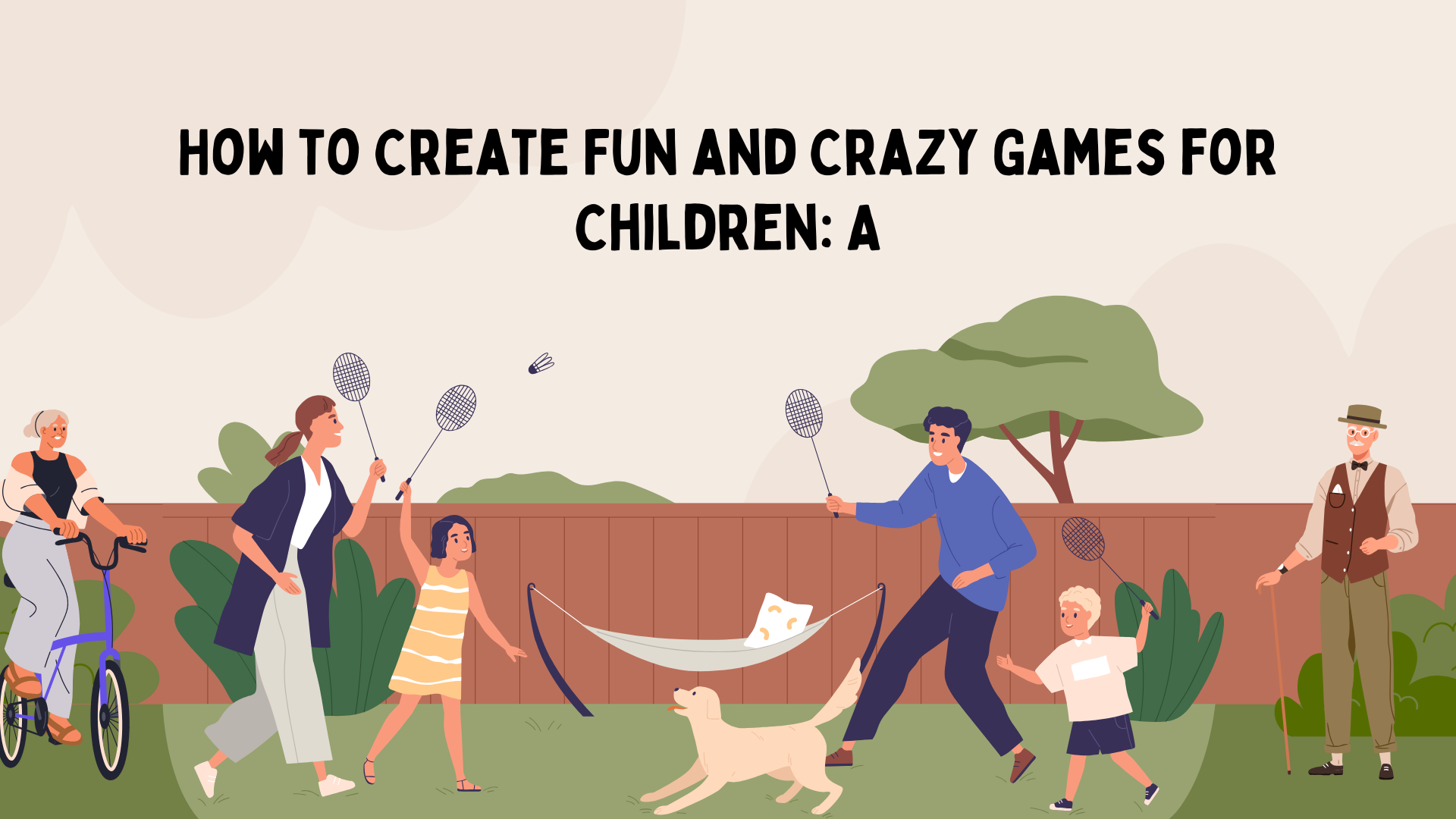Table of Contents
Introduction
Children are born explorers, so to say: they like to explore and create. To learn, kids should be surrounded by things which provoke their sense organs, inspire them to think in new ways and help them show their own world. Although board games will never go out of style, there are surely other “nuts” that could be truly played. And then, they could also be tools for education-at least, tools for teaching one how to resolve problems and be effective in speaking with others.
One of the most rewarding times as a parent or caregiver might be in creating games for children. I very vividly recall that at the point in which I began leaving out the fun childhood board games I used to have for them, I created an outdoor fun game series to which they quickly grew fond of. It’s irreplaceable how excitement and liberty started overtaking their childhood life. So, if you need a few suggestions for inventing humorous games that will trigger a frenzy storm in a child’s thoughts, you’re on the right platform.
In this piece, we shall have fun with all the fun educative games you’ve ever thought existed. Be they indoor or outdoor-based games or self-made games which will get those creative juices within you. Our tips are invaluable for helping with any idea regarding crazy games importance for children.

Before stepping into game development, it is very important to know why “crazy” games are so good.
Traditional games are good, but sometimes it is the wacky and unconventional games that leave lasting impressions.
1. Encourage Creativity: Crazy games make children think out of a box, which will develop thinking creatively and problem-solving skills.
2. Physical and Mental Stimulation: For most wacky games, children will have to run around, meaning all that energy is utilized while encouraging coordination and motor skills.
3. Teamwork and Social Skills: For most games which involve more than one player teach kids on how to communicate, collaborate, and understand the idea of teamwork.
4. Learning through Play: The wackiest games may even have an educational aspect to them, whether in terms of math, language skills, or maybe even science concepts-all while keeping the kids entertained.
How to Create Fun and Crazy Games for Children: A Step-by-Step Guide
Actually, nothing should be extremely hard to find for creating very funny and nuts games. Truly, some exciting games come straight from a slight spark of one’s imagination. Here is what you can get started with.
1. Find your objective:
What the game aims to achieve: Before you come up with your game, determine what you would like the game to achieve. Do you want to build the physical skills of a child, teach children to be problem solvers, or create an outlet to burn off some energy?
Personal Experience: I designed one game called “The Great Obstacle Course,” which will make my children more active and teach them how to be a team player. In other words, I wanted my children to be an active kid and a team player, and I prepared a set of challenges for them in the backyard in the form of crawling under tables and hopping over cushions.
2. Get Familiar with the Age Category
The age range of the children will determine the type of game. The little ones, who range between the ages of 3-5 years, will be fine with a game that has low rules and easy instructions. On the other hand, the older group of children within the ages of 8-12 will suffice for complex or competitive games.
For the kids coming from younger ages, an example can be taken in the game. For example “Animal Charades” wherein through miming movement and sound one can create scenarios that promote activities and creativity to both of you.
Sample game for older children. Older ones can have room escape challenges too. Maybe such challenge exists in the homemade version at one’s very own house whereby puzzles and clue are included packages with a time out timer.
3. Activity with Movement
Kids love the game that helps them move and run and jump around. The craziest games can actually be active in the sense of getting kids out of their shells to expend the energy. Also, movement games help children practice coordination, balance, and even fine motor control.
Game Concept: “Balloon Pop Relay”. The kids are supposed to run around the room or the yard popping the balloon alone without hands. The team that pops all their balloons first wins.
4. Switch It Up Rules
Crazy games do not need to be normal. Sometimes breaking the rule or a twist might be funnier. It is unpredictable, and the game catches the attention of the child.
Example: “Reverse Tag” – Here in this game of tag, the person labeled as “it” runs away from the others rather than catching them. The twist makes it even more interesting.
5. Think Creatively About Props
Households and outdoor equipment can creatively be applied in designing exciting and different games. Chairs, ropes, cushions, and even paper towels can be used in games if your imagination is creative.
Personal Anecdote: I think one of the most fun and crazy games I ever designed was nothing less than a roll of toilet paper. I turned the living room into a “toilet paper maze” where kids had to wriggle their way through tunnel after tunnel of paper without knocking it over. I guess the more the mess the better.
6. Set the Scene
It can also make the game more enjoyable by making it a story. Kids like to pretend to be part of an adventure either pirates searching for treasure or a superman or lady saving the world. Add props, themes, and challenges that go along with the story you are coming up with.
Example Game: “Superhero Academy”-Each child receives some type of “superpower,” whether invisibility or super speed. They do a range of challenges-from rescuing a stuffed animal to running toward a finish line-in order to successfully graduate from the academy.
7. Make It Educational (Without Them Knowing It)
Even the most odd games can provide you with critical pieces of information. You do not have to teach a game in a lesson but just learn by playing. Children will pick some concepts instinctively while playing little games.
Example: “Treasure Hunt Math” – Hide clues throughout the house that end up leading kids to different math problems. Once they solve these problems, the next clue reveals itself, finally leading them to a “treasure” of some sort which could be some small prize or treat.
8. Be Flexible
At times, it’s best when you entrust the kids with carte blanche to determine their own rules or ideas. That way, creativity will always be present to make the fun more enjoyable to everyone. Just let the children have the control of some game aspects, and you will never believe what you will get from them.
Personal Story: I could set up the scavenger hunt, then hand the choice to find the next clue over to my kids. This led them to find a challenge that read “Find something that rhymes with ‘banana.'” Their creativity made the game into an even more adventurous ride than what I had ever envisioned.

Popular Fun and Crazy Game Ideas for Kids
Here are some tested games to get you started on some creative fun:
1. Silly String Chase
This is one of the silly string games full of energy. The point is just to chase and “tag” other players with silly string without getting tagged back.
2. Lava Floor
The children have to step on the “lava floor” over places designated as safe zones such as cushions or pillows. In all, this game will give a well-balanced feeling of coordination along with swift thinking.
3. Color Relay
This relay race has colors. Each child must find something inside or outside the room that is the color of the one called out. It’s a very fast-paced, competitive game that’s fun for all ages.
4. Paper Airplane Target Practice
Make paper airplanes and set up a series of targets for children to hit. The challenge can be made more difficult by moving the targets or adding obstacles.
5. Indoor Camping Adventure
Camp it in the living room. Make tent blankets, play “Shadow Puppets,” have a campfire (round of chairs), and play other fun games.
How to Design Fun and Nuts Games for Kids: Conclusion
9. Use Nature as Your Playground
Nature is a great place where you can have lots of fun and crazy games. It could be the park, the beach, or your own backyard, but with nature, anything can be an exciting adventure zone.
This activity can be held outdoors as follows: Outdoor Game Idea. “Nature Scavenger Hunt”. Prepare a list of common things that may be found in nature; for example, a pinecone, a feather, some sort of leaf or a smooth rock, etc. Give the children a set time frame and encourage them to seek out and check off items on that list. And, if they are willing, include riddles to give them a better sense of how to search for those elements.
Nature games give children enough time to learn appreciation of the environment. It expands the skills developed in observation as well as critical thinking.
10. Obstacle Courses and Time Games
Little children love adventure, and how exciting it gets when a seemingly fun game is a timed race for them. Pillows, chairs, or cones for obstacles will hone their concentration. Competition will take over.
Game Idea: “Time Trials Obstacle Course” – Set up an obstacle course in your living room or backyard, using whatever items you have available (e.g., cushions, cones, or even strings tied between trees). Time each child as they navigate the course and encourage them to improve their time with each attempt. You can even offer rewards or medals for achieving the fastest times.
11. Turn Everyday Activities into Games
Sometimes the best games in life are constructed from basic, mundane chores such as washing the dishes or carrying groceries. For most kids, carrying groceries can become a real chore, but with them challenging each other; it just seems very exciting.
Game Idea: “Laundry Relay Race” Make the kids fold towels or sort laundry, but with a twist! Who folds a towel faster? Who can sort colors from whites quicker? The competitive edge to mundane activities makes ordinary tasks become fun events and the kids go home feeling satisfied about the job.

12. Play with Food!
Playing around with food is not really a method of necessary eating. Further, the authors state it could also be extremely educational and creative, depending on what kind of games are played. Foods are played in games that consider imagination, science, and a little art.
Example Game: “Food Art”. Create a creative station with fruit, vegetables, and any other edible as if to do some sort of creation just with food alone. Get kids to produce facial features and animal shapes. Alternatively, an abstract art would create a taste adventure by offering excitement for exploring the different forms of foods.
Healthy food games in your plan will make them excited about healthier eating and introducing new tastes but letting their creativities flow too.
13. Themed party games on special occasions; sometimes, at themed parties, the craziest and memorable games occur there. Whether one is holding a birthday celebration, holiday party, or just marking the weekend away, these are perfect events in creating new, fun games that represent the theme of the day.
Themed game idea: Superhero Training Camp-At the superhero-themed party, kids can take training exercises designed to develop their “superpowers.” Training might include activities like a laser beam dodge using red yarn or attempting to drag an object a given distance in the strength challenge.
Themed games create further dimensions of participation and excitement at the event that is sure to leave everyone’s day unforgettable.
14. DIY Craft Games
It can be a great bonding opportunity with your children, and when combined with fun games, it becomes a full-fledged creative experience. Let the kids create their own game pieces, then use them in a wacky game!
Cardboard Maze: Create a maze game with markers and tape in a cardboard box. Once they create the maze, they can race through it with restrictions like “do not touch the walls” or “use only your non-dominant hand.”
Craft games enhance good fine motor skills, spatial awareness, and problem-solving skills of a child and enjoy the activity.
15. Technology to Engage Kids in Interactive Games
Technology in the present digital world can be very entertaining and learning as games played by children. One can create very interactive and crazy games that bring in both physical and mental activities through the right apps, devices, or online platforms.
Digital Game Idea: “Virtual Treasure Hunt” Design an AR treasure hunt using a tablet or Smartphone. Ensure that children can trace clues easily on the screen and use real-world object scans to locate virtual objects hidden within it. The activity with solving problems and the technology makes this pretty intriguing for older kids.
How to Engage Them in Silly Games
1. Connect It with Their Interests
Every child is unique with a different interest in hobbies. Maybe some are really interested in exploring space, whereas others are simply fond of animals or sports. While developing any game, the idea is to include such things that interest their minds and evoke imagination.
For example, your child loves dinosaurs. Here is a game called “Dinosaur Chase.” Run away from those “T-Rexes” and collect the eggs hidden in your yard.
2. Turn it into a Group Activity
Children are social beings; they do well and adapt fast in group settings. Try making the game a team activity that requires teamwork every time it is possible. Not only will the children be exhilarated and enjoy the game more, but they will also learn important social skills like sharing, cooperation, and even empathy.
Example: A game like a scavenger hunt or relay race is always performed in such a way that all children are of one team. One can give labels to the members with such distinctions as “leader,” “navigator,” and “runner” so each will have a role to play in the activity.
3. Use Reinforcement
A child responds well to positive affirmations. The children are motivated by awarding them with stickers or even a high-five whenever a task is completed or any goal achieved.
FAQs
1. At what age should the child be chosen in order to create crazy games?
This would mean that the game can be as crazy as needed for each age group. Simpler versions may require so much moving around for young children. For older kids, one might consider complex or competitive types.
2. How do you know the game is safe enough to be played with kids?
Safety first. The children should always be kept under watchful eyes when playing around, especially in an open free space that carries fewer hazards. Use items that are not sharp nor breakable as props; activities to be offered should be compatible with the age.
3. Can I introduce educational games which the kids do not even notice?
Absolutely! One simple way to teach while they play is by infusing educational elements into fun and crazy games. You can, for example, make simple math problems, reading challenges, or geography questions into the games, thereby enriching them.
4. Do I need special props to create crazy games?
No, no, wild stuff games can easily be done with some things at home. Be creative about what is available in front of you-polyfills, strings, cardboard pieces, even in the kitchen all utensils could come alive as part of the game
5. What would help encourage team play in the wild games?
Games like scavenger hunt, obstacle race, relay can all work within teamwork. It’s important they know they’re supposed to pull together and to divide and conquer with the rest of the children.
Conclusion
The most pleasing ways to spend time together, though, have to be the creations of fun and wacky games with children. A suitable game, however one might burn off energy or learn something new, can really make any situation into a funny memory. Read on for some ideas and then go forth and make your own, keeping in mind that all this is just in the name of having fun and making memories to last a lifetime. So, what are you waiting for? Let your imagination run amok and start crafting that next big adventure for your little ones today.

